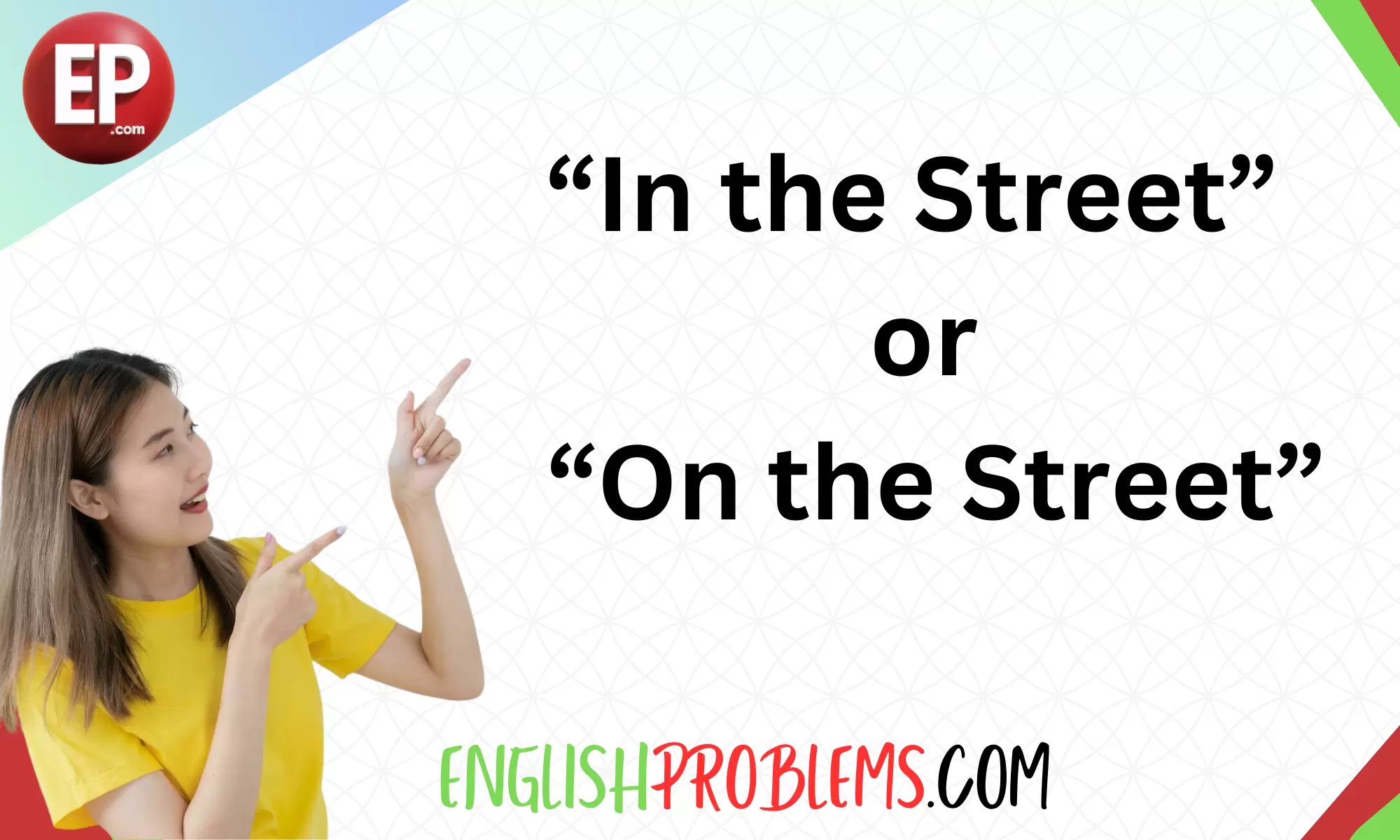Mastering prepositions is key to mastering English. Prepositions like “in” “on” and “at” often cause confusion because they can dramatically change the meaning of a sentence.
One of the most common conundrums is understanding the difference between “in the street” and “on the street.”
This article dives deep into the nuances of these phrases, providing clarity and practical examples to help you use them correctly.
The Significance of Prepositions in English Phrases
Prepositions are essential in English as they link nouns, pronouns, and phrases to other words in a sentence. They typically indicate relationships of time, place, direction, and method. Incorrect use of prepositions can lead to misunderstandings. For instance, “She is in the street” implies a different scenario than “She is on the street.”
Why Prepositions Matter
- Clarity: Proper use ensures the message is clear.
- Meaning: Prepositions can change the entire meaning of a sentence.
- Flow: They help in creating a natural flow in writing and speech.
Defining “In the Street” Through Usage and Context
“In the street” often conveys a sense of being surrounded by the street or involved in an activity happening within the boundaries of the street.
When to Use “In the Street”
- Immersion: When someone or something is fully within the street.
- Example: “Children were playing in the street.”
- Events: Refers to events or actions taking place within the street.
- Example: “There was a parade in the street.”
Examples from Literature and Everyday Conversation
- Literature: “The car broke down, and he found himself stranded in the street.”
- Conversation: “I saw a group of kids in the street.”
Connotations of Danger or Immersion
“In the street” can sometimes imply danger or immersion, suggesting someone is within the traffic or activities of the street.
Exploring the Meaning of “On the Street”
“On the street” usually indicates being on the surface of the street, emphasizing location rather than involvement.
When to Use “On the Street”
- Location: Describes where someone or something is situated.
- Example: “There’s a new café on the street corner.”
- Observation: When observing or noting something visible from the street.
- Example: “There was a poster on the street.”
Examples from Literature and Everyday Conversation
- Literature: “He walked on the street, enjoying the cool breeze.”
- Conversation: “I parked my car on the street.”
Connotations of Location or Surface
“On the street” typically focuses on location, suggesting someone or something is situated on the surface of the street.
Grammatical Guidelines: When to Use “In” vs. “On” in Sentences
Understanding the grammatical guidelines helps avoid common mistakes and ensures clarity in communication.
Clear Rules and Guidelines
- In the Street: Use when referring to being within the boundaries or part of an activity.
- Examples:
- “The children are playing in the street.”
- “The festival is happening in the street.”
- Examples:
- On the Street: Use when referring to something located on the surface or observable from the street.
- Examples:
- “There’s a bench on the street.”
- “The lamp post is on the street corner.”
- Examples:
Common Mistakes
- Saying “on the street” when you mean “in the street” can confuse the listener about the exact location or involvement.
- Incorrect: “They are dancing on the street.” (Implies on the surface)
- Correct: “They are dancing in the street.” (Implies within the area)
Emphasizing Locations with “On”
Using “on the street” places emphasis on the specific location.
Examples Showing Emphasis on Place
- “The sign is on the street.”
- “He lives on the street called Elm.”
Visual Aids for Better Understanding
- Diagram: A street with markers indicating “on the street” locations like benches, lamp posts, etc.
Conveying Action with “In”
“In the street” often emphasizes an activity or action happening within the street.
Examples Showing Emphasis on Activity or Occurrence
- “Protests erupted in the street.”
- “Vendors are selling goods in the street.”
Visual Aids for Better Understanding
- Diagram: A street scene with people engaged in various activities to illustrate “in the street.”
Are “In the Street” and “On the Street” Ever Interchangeable?
There are rare instances where “in the street” and “on the street” might be used interchangeably, but these depend heavily on context.
Situations of Interchangeability
- General Observation: Sometimes, both can be correct depending on what aspect is emphasized.
- Example: “There are many cars in/on the street.”
Contextual Nuances
- Focus on Action: “In the street” focuses on involvement, while “on the street” focuses on location.
- Regional Preferences: British English might prefer one over the other in specific contexts.
Real-world Examples
- “There are musicians performing in the street.” (Action-focused)
- “The new billboard is on the street.” (Location-focused)
Clarifying the Less Common “At the Street” Expression
“At the street” is less common but has specific uses.
Explanation and Contexts
- Specific Point: Used to indicate a precise point.
- Example: “I’ll meet you at the street entrance.”
- Rarity: Less frequently used compared to “in” and “on.”
Comparison with “In” and “On”
- In the Street: Within the boundaries.
- On the Street: On the surface.
- At the Street: Specific point or entrance.
Understanding “At” for Specific Meeting Points
“At” is often used for specific meeting points or precise locations.
When and Why to Use “At”
- Meeting Points: Precise spots where people meet.
- Example: “Let’s meet at the street corner.”
Examples of “At” in Specific Locations
- “She was waiting at the bus stop.”
- “He stood at the corner of the street.”
Importance of Precision
Using “at” ensures clarity when specifying meeting points or exact locations.
Real-world Examples: How “In” and “On” are Employed in Everyday Language
Everyday Speech and Media
- Speech: “I found a wallet in the street.” vs. “I saw a wallet on the street.”
- Media: Headlines like “Protests in the street” vs. “New artwork on the street.”
Analysis of Examples
- In the Street: Emphasizes immersion or involvement.
- On the Street: Highlights location or surface.
Trends in Different English-speaking Regions
- American English (AE): More likely to use “on the street” for location emphasis.
- British English (BE): More nuanced use of “in the street” for actions within the street.
Adapting Preposition Use to the Context: AE vs. BE Variations
Understanding regional differences helps in accurate communication.
Differences Between AE and BE
- AE: Prefers “on the street” for both location and observation.
- BE: Uses “in the street” more frequently for activities.
Examples of Variations
- AE: “The car is parked on the street.”
- BE: “They are playing in the street.”
Tips for Adapting to Regional Differences
- Travel: Pay attention to local usage.
- Communication: Adjust based on the audience’s preference.
Conclusion
Prepositions are vital for clear and accurate communication in English. Understanding the nuances between “in the street” and “on the street” ensures that you convey your message correctly. By considering context, action, and location, you can master the use of these prepositions. Whether you’re writing, speaking, or simply observing, these guidelines will help you choose the right preposition every time. Keep practicing and pay attention to the subtle differences to improve your English proficiency.

Dariel Campbell is a language aficionado dedicated to demystifying English problems for learners worldwide. His approachable writing style and thorough explanations turn confusion into clarity. With Dariel’s guidance, mastering the English language becomes a rewarding and empowering experience.


